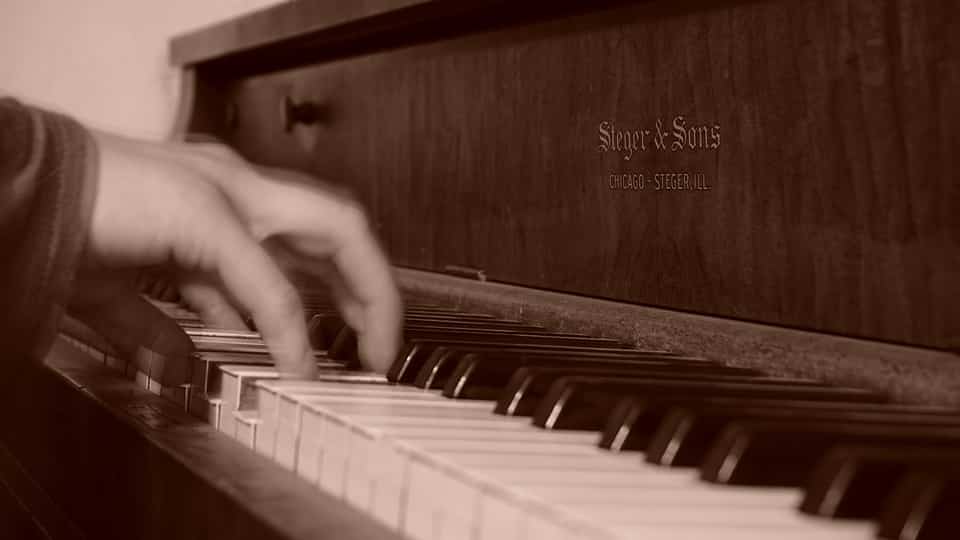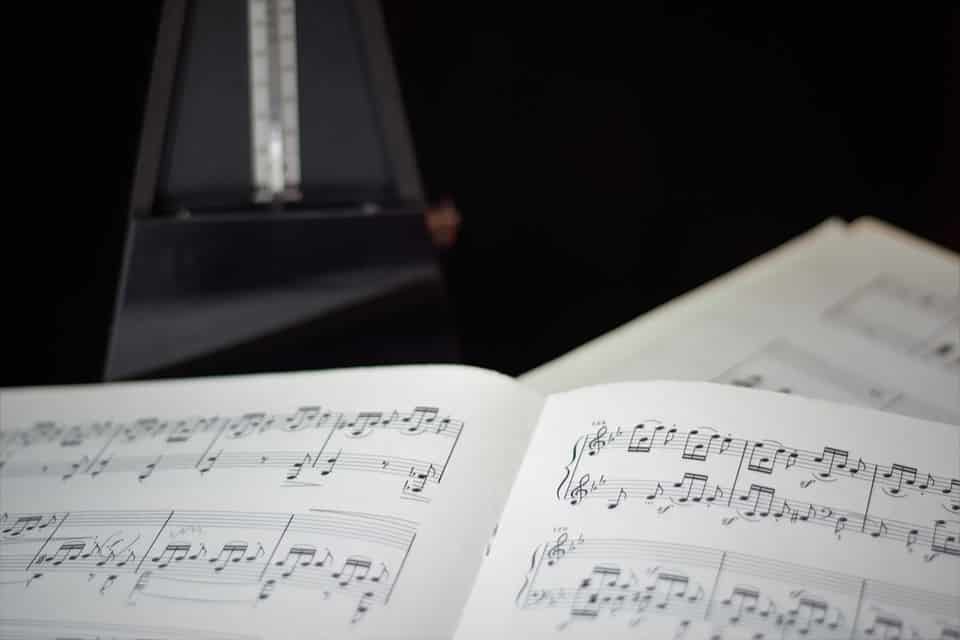One of the great things about the internet is that it has allowed evolution and advancement in so many industries. For example, in business, tools like Slack and Zoom allow you to communicate with colleagues on the other side of the world as if they were in the same office. The music industry is no exception, and in particular piano lessons.
It’s been possible to get piano lessons online for several years, but what exactly are they, and how do they work? Are they really a viable substitute for an in-person teacher, or are they a waste of time and money?
Just as an aside, we’re putting together a waiting list for online piano lessons at The Honest Pianist. At the moment, we’re simply gauging interest, so if you’d like to be notified if and when we offer online piano lessons, please provide us with your name and email below.
What Are Online Piano Lessons?
There’s a little confusion as to what constitutes an online piano lesson. Does something like Flowkey constitute an online piano lesson? What about a course from Udemy? Does that qualify?
Well, in short, no. What we’re talking about here is one to one, dedicated, live piano lessons with a teacher. You’ll have the freedom to ask the teacher any questions you have, as well as receive feedback on your playing, live. Think of them as a substitute for an in-person lesson with a teacher if you’re not able to get to one, or if there isn’t one in your local area.

Generally, these lessons are done over Skype, Zoom, or similar video conferencing client. However, depending on which part of the world you’re in, or which teacher you choose to go with, the software may differ. Some teachers even have a dedicated messaging app, whereby they can send sheet music and lesson feedback instantly without having to make notes in pencil or send away for expensive sheet music books.
All this allows you to have a very personalised piano learning experience, almost exactly as you’d have with an in-person teacher, but from the comfort of your own home and from your own piano. What’s not to like?
How Are Online Lessons Different From Online Piano Courses?
Now, regular readers of this blog will know that I’ve written an article on Flowkey, and that I think it’s an excellent tool for those who don’t have the money or aren’t yet ready to commit to regular weekly lessons. And that’s fine; Flowkey certainly has its place in the library of piano learning tools.
However, I have also repeatedly said that the best way to learn the piano is with a live, in-person teacher. And online piano lessons could be a perfect alternative if you’re considering something like Flowkey, but want something a bit more comprehensive.

But what are the benefits of in-person online piano lessons versus an online piano course?
Online piano lessons provide you with instant feedback.
Don’t think of an online piano lesson as an alternative to an online piano course. Think of it as a substitute for an in-person teacher. What online piano lessons offer you is instant feedback from an experienced teacher, which is something you just can’t get from a course, or from videos on YouTube. The teacher can tailor their teaching style to your playing and will be able to work out a plan of attack to improve your playing. This plan will be bespoke to you and only you, and not the millions of other people who’ve already bought Flowkey or any of the other courses you’re looking at.
An online teacher can spot mistakes very easily.
With a good camera setup, an online teacher will be able to instantly spot your mistakes. When you’re learning the piano, you might not pick up on all the mistakes and errors that an experienced teacher would, and an online piano course is certainly not going to help identify your mistakes for you. You’re left on your own, and sometimes this can be damaging, as you have nobody to ask for advice. An online piano teacher can point you in the right direction and help you correct your mistakes.
It’s worth saying that as with anything in life, you get what you pay for. You’ll pay more for online piano lessons (although no more than what you’ll pay for in-person piano lessons) than you will for an online course, but I guarantee, as a pianist and teacher of many, many years, it’s worth the extra cost.
How Do Online Piano Lessons Work?
Let’s get into the details of how you actually go about finding an online teacher, and setting up your workspace for lessons.
Firstly, you need to find someone online to teach you. This shouldn’t be too hard; online teaching isn’t majorly popular at the moment, but lots of people do offer it, and a quick Google search will show you plenty of teachers ready and able to teach you.
It would be remiss of me not to say that we’re looking at offering this service here at The Honest Pianist. If you’re interested, you can fill your name and email at the top or bottom of this page and we’ll let you know as and when we set up our service. It’ll be competitively priced, and taught by one of two teachers; either myself, a Bachelor of Music, or my wife who has a Master’s in music.

So, once you’ve found your teacher, you’ll need three things:
- Your own piano. It doesn’t have to be fancy; if it’s a digital piano or keyboard, that’s fine. If it’s an acoustic, that’s also great. As long as it’s roughly in tune, and it works properly, it’ll be fine.
- A camera/smartphone/laptop. Again, you don’t need a dedicated camera for online piano lessons, although it helps. Any modern smartphone will have a camera and a microphone that’s good enough for lessons. Just make sure that it gives a clear picture and the sound works, so you can hear your teacher when they give you feedback.
- A computer. You’ll usually need a computer to run the conferencing software, and to view the teacher’s feedback. This isn’t mandatory; you’ll of course need one if you’re using a separate camera and microphone, but if you’re using your phone, this should be fine.
Bonus equipment; not necessary, but definitely will enhance your experience.
- A tablet/iPad. Tablets are a fantastic way of displaying sheet music, and if you have one, it might save you some money in the way of purchasing scores. It’ll also allow your teacher to send scores to you for sight-reading or learning.
- A USB-MIDI interface. Most modern digital pianos come with this, and if you have a computer to connect it to, it’ll provide your teacher with crystal-clear audio quality. Of course, if you have an acoustic piano, this isn’t necessary.
Test your equipment and make sure that it works properly. The last thing you want is to have communication or technical problems when you’re having a lesson. You’ll also need to make sure your internet is reliable and fast enough to stream video without interruptions.
Your teacher will probably want to get to know you in the first lesson, as well as make sure all your equipment works as expected. They might get you to play a piece to them, to ensure they can hear your piano properly. You’ll receive some good feedback, and you’ll get an idea of whether the teacher is right for you, and whether you want to continue with them.
What’s more, most teachers offer this first lesson free or discounted, so there’s nothing to lose, although not all teachers do. Make sure you check the teacher’s policies before you schedule a lesson.
What Are the Drawbacks of Online Piano Lessons?
Of course, like anything, there are bound to be drawbacks to having online lessons. These aren’t really too much of an issue for most people, but they are worth bearing in mind before signing up and paying a lesson fee.
You need a fast internet connection.
The last thing you want when you’re trying to communicate with your teacher or play a piece to them is a laggy connection. For online piano lessons to be useful, you’re going to have to have an internet connection that can stream high-quality video. Most homes in large cities have this capability, but if you’re in a rural area or less developed country, you may struggle.
You may need to purchase equipment.
We’ve already spoken about the equipment required. It’s generally not a huge list of requirements, but if you don’t have it, you’ll need to go out and buy it. We’d certainly advise you to make do with what you’ve got, but if you don’t have a computer or a smartphone, online lessons won’t be much use to you.
They’re more expensive than piano apps or online piano courses.
I don’t really consider this a drawback; again, you get what you pay for. However, if you’re on a tight budget, online piano lessons may not be an option for you in the same way that in-person lessons might not be an option if they’re too expensive. However, realise that you’re getting a lot more for your money if you sign up for lessons.
How Do I Sign Up for Online Piano Lessons?
Like we’ve mentioned, we’re currently scoping out interest in this. If we get enough feedback, We may launch our own online piano studio. Watch this space!
If you can’t wait that long, you’ll need to do a Google search for another teacher. They should be very easy to find; there’s a number of very famous YouTube names that offer this service.
In the meantime, happy practicing!

Very interested for my 8 yr grandson
Would like to know what are the price ranges?
I m a piano teacher in Srilanka and want to take a practicl lesson .
Normally we can do a theory but difficult to take the lesson.
Pls kindly advised specially for my beginers whst cn they do?
I’ve had approximately two years of lessons as an adult but it was many years ago. I don’t want to develop bad habits because I don’t remember exactly how to do something.
I get weekly bassoon lessons via Zoom from my long-standing teacher, who now lives very far away, because I changed countries. And where I live now, I would be very unlikely to find in-person lessons closer than 100km. On-line works well, but there is one feature of a face-to-face lesson that can’t be emulated online. On Zoom (or alternatives), no matter how good your internet connection is, simultaneity isn’t possible. I can’t play to my teacher’s indicated beat (which might be very helpful when trying to get irregular rhythms right) because I see her slightly late and she hears me later still. And face to face, with all my teachers, every lesson used to end with student and teacher playing together. That can’t happen on-line. I miss those duets, but there is no way around it. That is not saying online lessons don’t work. They do. But they are not quite the same.